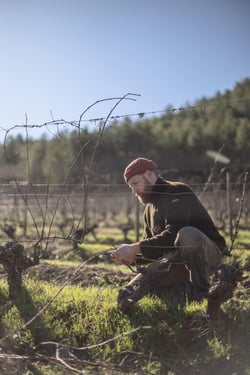
7 0 8846 KM
Today, I cultivate and vinify 4.16 hectares of vines located between 450 and 500 meters above sea level on a north-facing slope, on beautiful terroirs of clay-limestone and outcropping black marl from the Oxfordian period (150-160 million years ago). The vines I took over had been cultivated biodynamically for several years, and the winery was established in a former silkworm farm. In the heart of the Clairette vineyard, my original grape varieties are quite classic: a lot of Muscat Blanc à Petits Grains, a little Clairette Blanche, and some Cinsault. I am gradually grafting one hectare of Muscat with old red and white Alpine grape varieties, traces of which have been found in the valley (Mollard, Feunatte, Picardan, etc.), to restore diversity to the vines and improve their resilience, particularly to climate change.
I work in the vineyard year-round using agroecological methods: gentle, physiological pruning, winter grazing with a small flock of sheep, maximum soil cover (every other row is sown with a multi-species fertilizer mix), interplanting with fruit trees (apple, pear, and other species planned), and features to promote biodiversity (pond, nesting boxes for songbirds and bats, etc.). The soil is minimally tilled, and treatments are supplemented as much as possible with herbal teas, decoctions, and fermented extracts to limit the doses of copper and sulfur (horsetail, nettle, yarrow, chamomile, etc.).
The grapes are harvested by hand, only in the morning to ensure they are as fresh as possible. Pressing is slow and gentle, and vinification is carried out with minimal intervention: SO2 is used only when absolutely necessary, and at final doses always below 30mg/L (total); rarely at bottling. Carbon dioxide saturation and rigorous sorting in the vineyard guarantee consistently impeccable quality.
To start fermentation, starter cultures are prepared for white wines. Maceration begins spontaneously.
After fermentation, the wines are left to rest throughout the winter to clarify and stabilize them. They are racked in the spring before bottling without fining or filtration, and bottled by gravity on a fruit/flower day.
In any case, they are made to be drunk, and I hope you enjoy them!
No red wines at the moment.
No rose wines at the moment.
FIND THE EVENT YOU ATTEND